Shalini Patel- Banana Tree Drawings during Lockdown/ Archana Hebbar Colquhoun
Shalini Patel’s drawings, some in pencil and others in charcoal were done during lockdown. Nowhere to go, nothing much to do outside with friends, acquaintances or passers-by; she had all the time on her hands and the opportunity to observe the banana trees in her neighbour’s yard. For these drawings the view was from the first floor balcony of her house.
It’s these banana plants that lent themselves to serve as artistic models to Shalini’s black and white drawings of 2021. Before we discuss the formal content of the drawings and Shalini’s very own interpretation of this tropical wonder of nature, let’s look at the distinctive form of a banana plant. In fact, there are three distinctive forms in the main within a single banana plant – the trunk, the fruits, and the leaves. A banana plant is often referred to as a tree due its size.
The trunk of a banana plant has a plump tubular form, soft, flexible, fibrous within and covered in layered sheaths, unlike the wooden trunks of shrubs and trees. The leaves are large, very large, and radiate out and become floppy all too soon. Each leaf is an individual growth separating out directly from the trunk, starting off as a cylinder that slowly unfurls and opens out to the familiar shape of a banana leaf. Then there are the bananas themselves, which grow in multi-levelled clusters, each banana pointing upwards and attached to a thick stalk that droops from the weight of several dozens of bananas, and at the end of the stalk grows a large purple-hued blossom of tightly packed petals.
All parts of a banana plant have their use. The fruits and the blossoms are edible, the leaves are used in cooking and most commonly serve as disposable plates in India, and the fibre in the trunks provide material for making ropes, baskets and mats etc. Parts of the trunk are also edible. It is said that each plant produces fruits and blossoms just once in its lifetime and then the plant is cut-down and in its place there’s a new plant ready and waiting to become a full-fledged banana plant. Considering this, Shalini’s drawings are perhaps the only record of the existence of those specific banana plants, which lived through the lockdown and by now will have become dead matter. Shalini observed the changes the banana plants underwent and recorded them in sketches and drawings.
Form and Content of the Drawings
Banana plants have been widely represented in Indian art and art of other countries. Although banana plants are ubiquitous in the tropical climate of India as Shalini said to me she had never before drawn a banana plant or its many plant parts until last year.
The drawings are variously titled “The Banana Tree,” “Composition from the Banana Tree,” “Friends to Look At,” “Song of a Bird,” “The Night,” etc. and “Composition,”
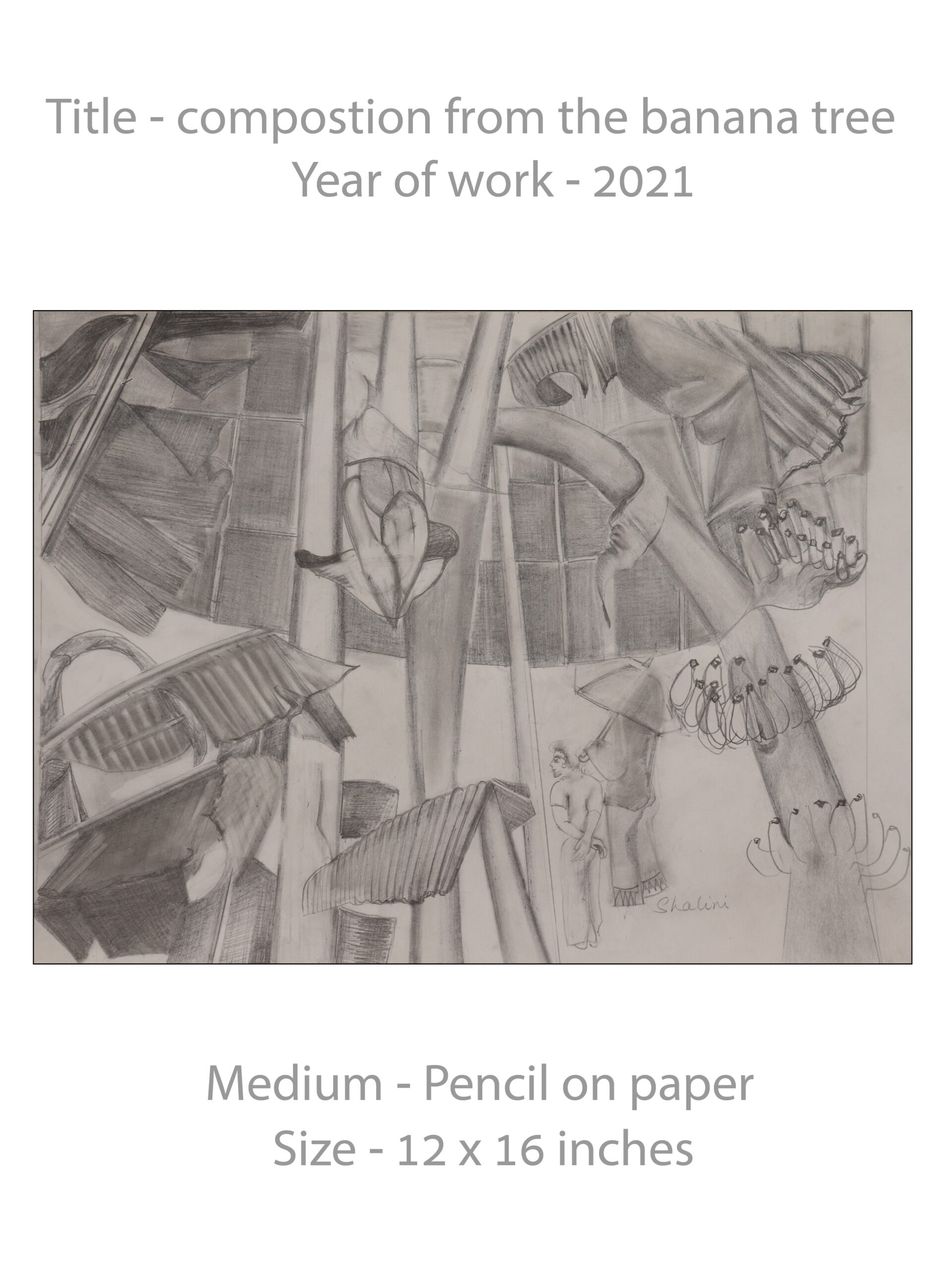
The works range from the depictive to the abstract. The earlier works in this group of drawings were more depictive such as those titled “Compositions from a Banana Tree” and progressively the drawings became more minimalist and abstract and simply titled “Composition.”
When an artist titles a work “Composition” or “Untitled” there is an immediate understanding on the part of the viewer that the subject matter or the formal reality of the work has been constructed as a design, bereft to a large extent of marks of identity as to what the work is about. The works titled “Composition” in Shalini’s banana tree drawings are arrangements of elements of a banana plant, such as a small section of a banana leaf, a portion of a stem or the trunk and other forms within the plant. Shalini devices ways to depict the forms and textures of a banana leaf such as the ridges that extend from the spine to the curvy edge of the leaf, which are a series of parallel lines, the leaf in the process of unfurling, and the natural splits that occur along the ridges in the leaf over time. We may presume that the various elements in any given drawing in this series are put together by breaking apart the view and arranging the elements into a composition drawn from the artist’s imagination.
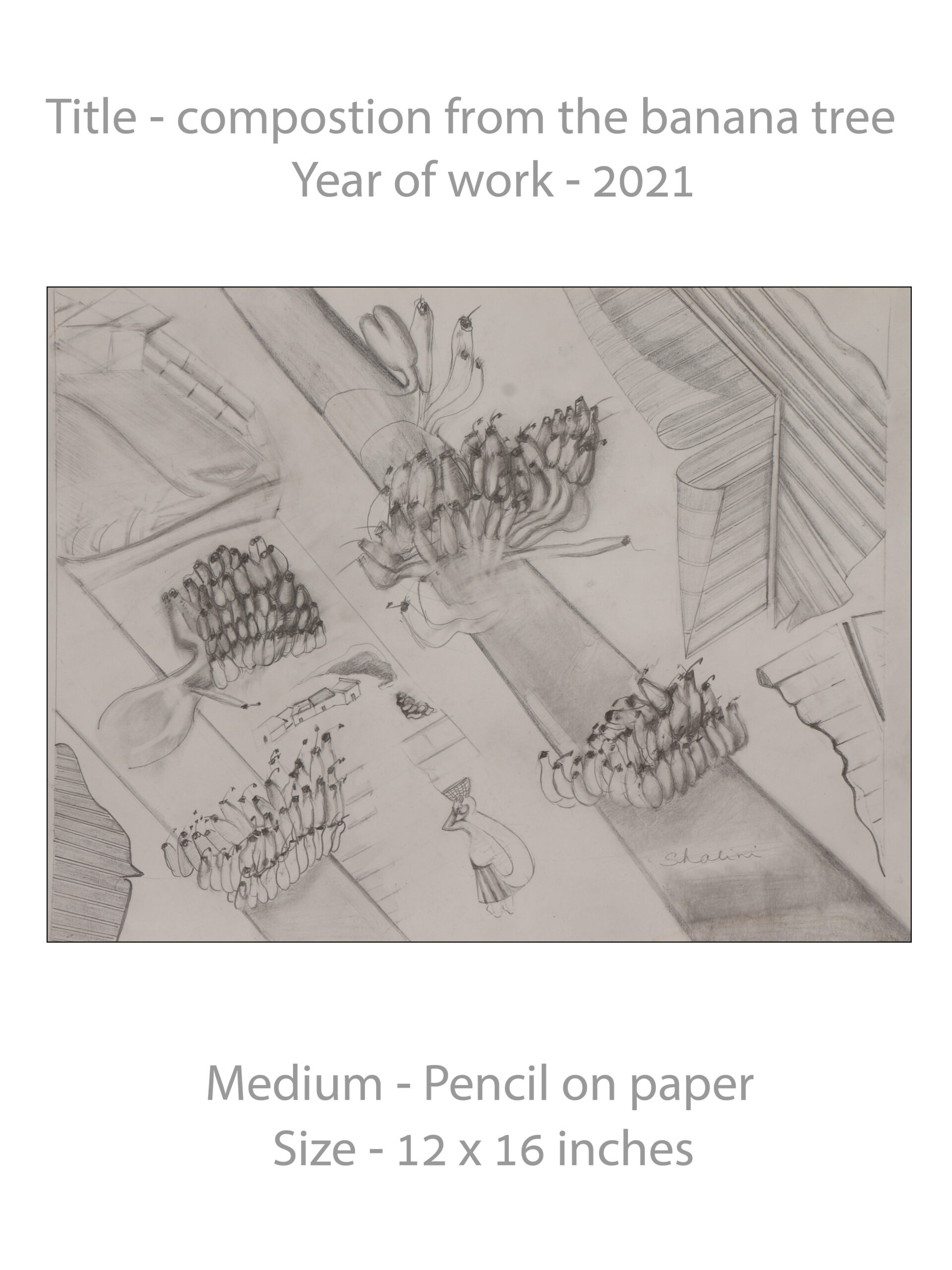
However, in the case of these works the compositions are as they existed within the growth of the banana trees, which the artist observed and then drew without rearranging any of the elements. It was a matter of merely selecting a frame consisting of a pre-existing composition that appealed to the artist. Still, it is to be noted that many of the drawings have compositions made up of diagonals and radiating lines, which we may not associate with the vertical trunks and the characteristic curved forms of a banana plant.
The compositions have areas that are filled with textures drawn from the banana plant with negative spaces in-between, creating a play of dark and light forms. Despite the abstraction and given the non-descriptive title “Composition” of many of the works they leave no room for doubt as to the source of the subject, namely, that the forms and textures are clearly drawn from a banana plant, however fragmented, and no other plant or object.
The title “Compositions from a Banana Tree” that many of the works carry is telling. The preposition “from” denotes that the artist is not the all-powerful creator for whom subject matter is something to simply reach out to and grab and make it the very own property of the artist. Through the title the artist acknowledges that the “Banana Tree,” the protagonist of the works, is the giver and the artist the receiver.
Many of the drawings have representational elements and are simple narratives of fleeting activities of birds and squirrels among the banana trees. The work titled “Friends to look at” is one such drawing where the elements are drawn with a sensitivity and expressiveness that I wouldn’t hesitate to say are feminine in their impact. The drawing depicts squirrels running along a wire, which crosses through banana trees. The work is not merely charming, it has the pathos of a life lived during a prolonged period of a global lockdown – pitting freedom against incarceration.
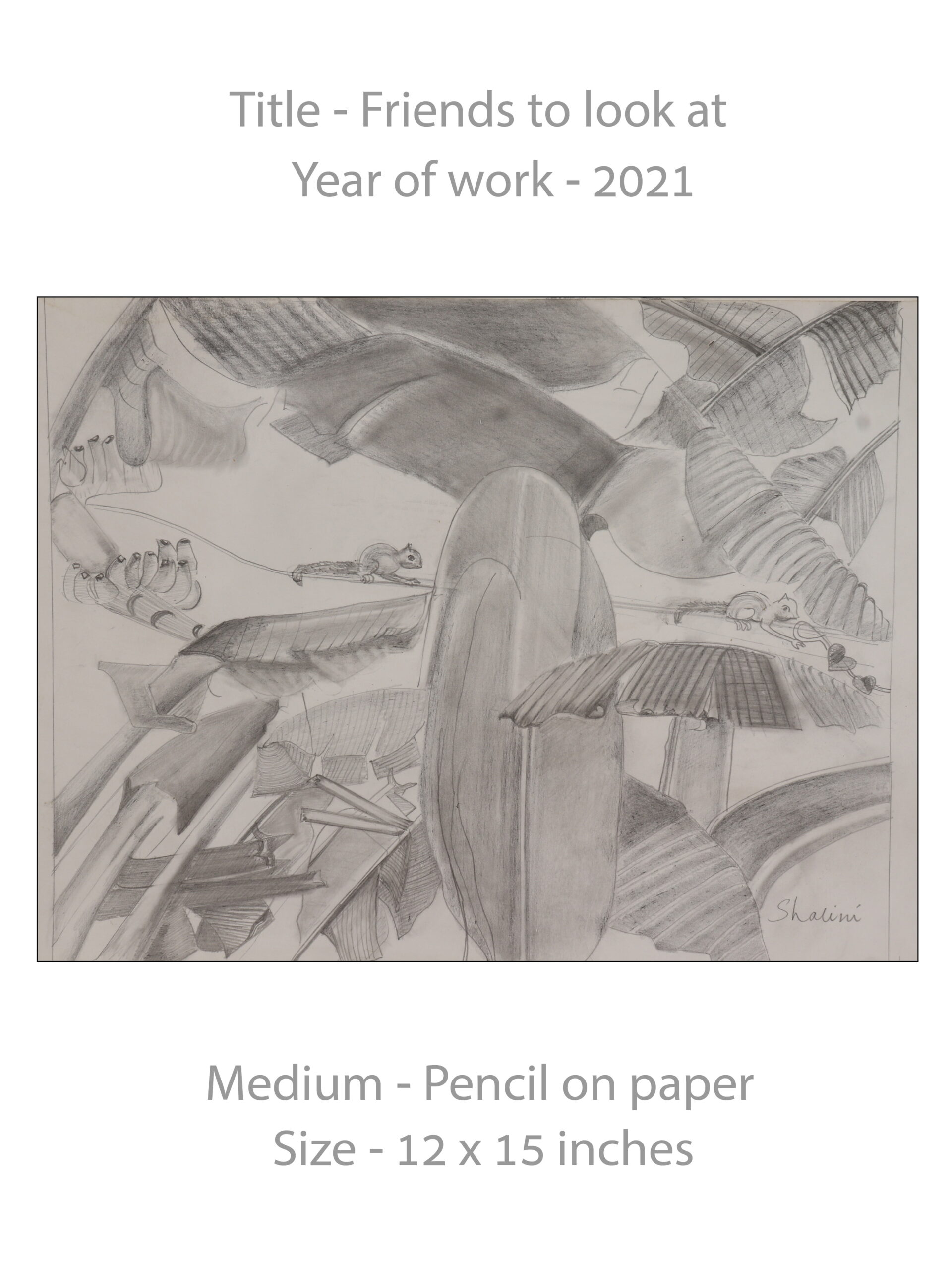
Another work, a charcoal drawing titled “Song of a Bird “shows a bird in the left foreground with its beak open. The work evokes sound through visual representation and by the choice of words for the title.
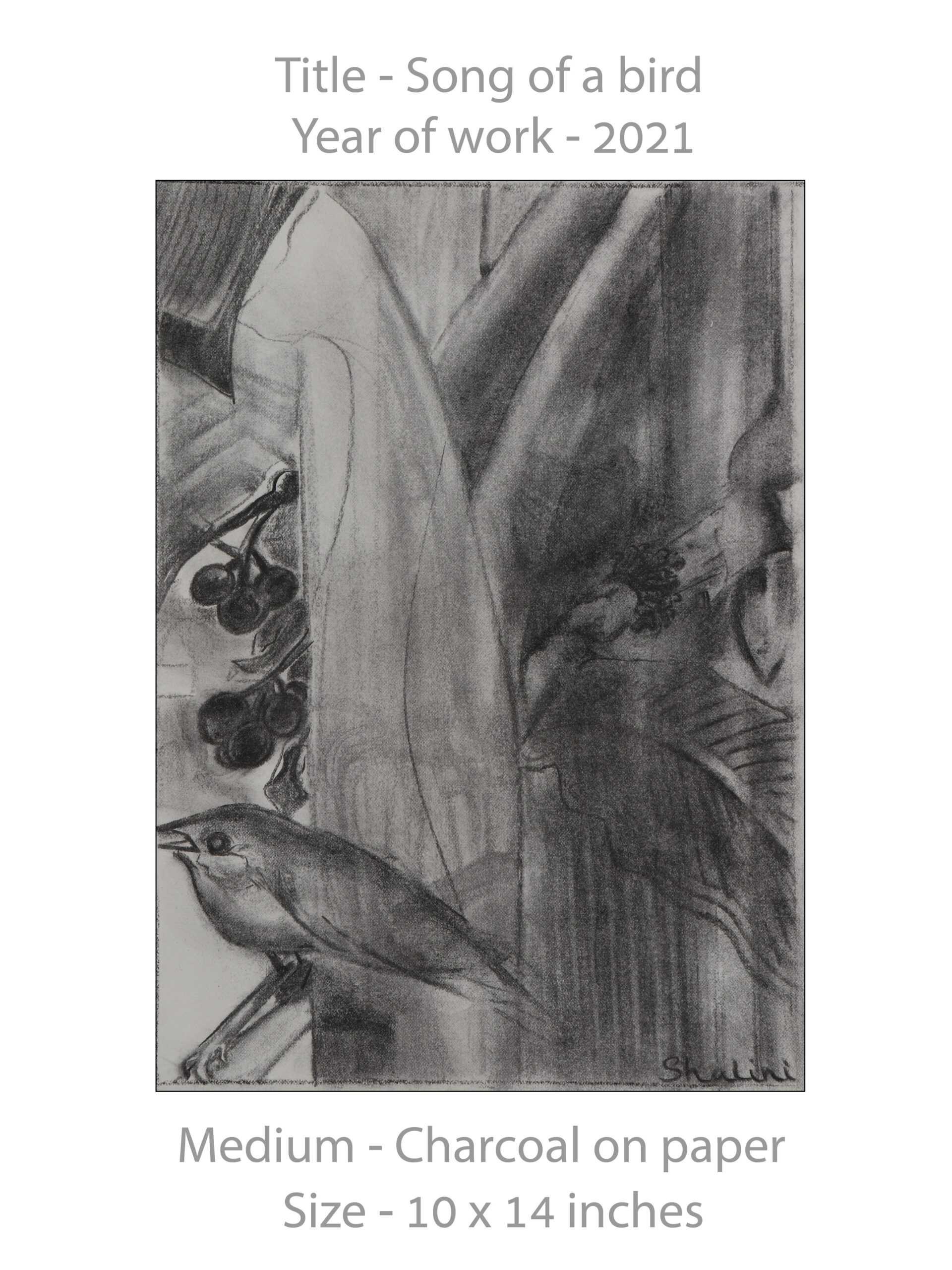
In some of the works we see people on the ground but they are diminutive in the presence of the seemingly towering banana trees. Even the clusters of upturned bananas look like groups of people wearing shrouds, huddled together. These works give prominence to nature and raise the debate of man Vs nature.
The work in charcoal titled “The night” has many surprising features. The night is not dark; however, the large banana leaf, again only a fragment of a leaf- its lower half- occupying nearly three quarters of the space within the composition – along with other elements in the drawing is depicted in dark tones. Touching the edge of the leaf is the full moon surrounded by a dark circle and in the vicinity is a lone star, prominent because of its shape that of the Star of David. Shalini’s interpretation of a night-time view is unique/original.
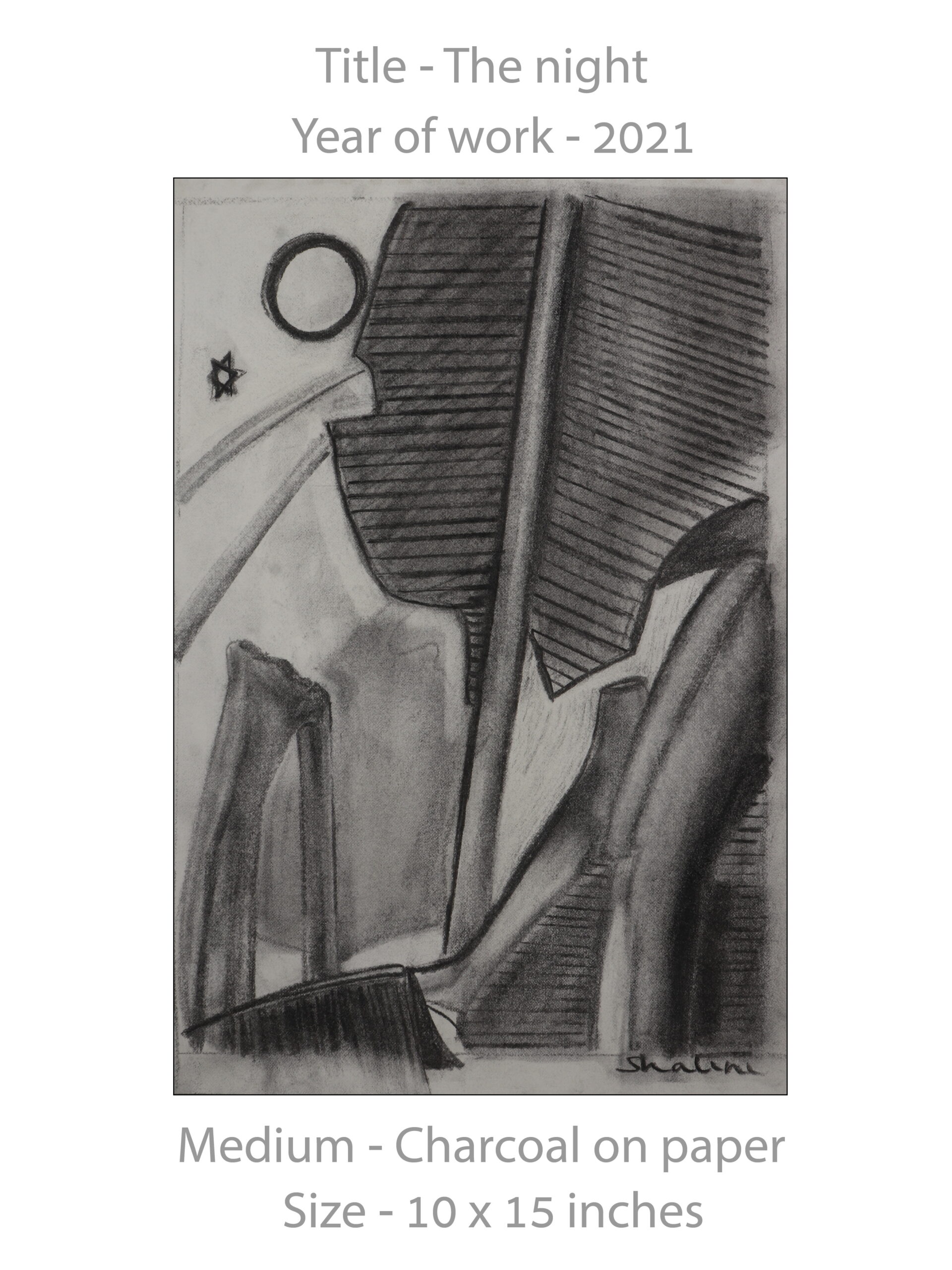
Shalini’s set of drawings titled “Harmony” are being exhibited in Bhilwara, Rajasthan, at Akriti Art Gallery from 5th. to 9th. Sept., 2022. The exhibition is sponsored by the Gujarat State Lalit Kala Akademi.